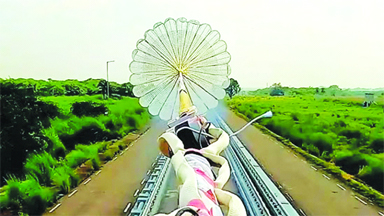ISRO has successfully conducted a series of tests on drogue parachutes, which would play a pivotal role in stabilising the crew module and reducing its velocity to a safe level during re-entry in the planned Gaganyaan human space flight mission. The Gaganyaan mission hopes to safely transport astronauts to Space and back.
Drogue parachutes are deployed to decrease speed and stabilise rapidly moving objects. ISRO’s Thiruvananthapuram-based Vikram Sarabhai Space Centre (VSSC) successfully conducted a series of Drogue Parachute Deployment Tests at the Rail Track Rocket Sled (RTRS) facility of the Terminal Ballistics Research Laboratory in Chandigarh during August 8-10, the national space agency said in a statement here on Friday.
The tests were conducted in collaboration with Aerial Delivery Research and Development Establishment (ADRDE)/DRDO. The drogue parachutes, packed within pyro-based devices known as mortars, are cleverly designed to eject the parachutes into the air upon command. These conical ribbon-type parachutes, boasting a diameter of 5.8 metres, employ a single-stage reefing mechanism, ingeniously minimising canopy area and mitigating opening shock, ensuring a smooth and controlled descent, the ISRO (Indian Space Research Organisation) explained.
During the three comprehensive tests conducted at the RTRS facility, a range of real-world scenarios were simulated to rigorously evaluate the performance and reliability of the drogue parachutes. The first test simulated the maximum reefed load, marking a groundbreaking introduction of reefing in a mortar-deployed parachute within India. The second test emulated the maximum dis-reefed load, while the third test showcased the deployment of the drogue parachute under conditions mirroring the maximum angle of attack experienced by the crew module during its mission.
“These successful RTRS tests serve as a critical qualification milestone for the drogue parachutes, confirming their readiness for integration into the upcoming Test Vehicle-D1 mission,” the statement said.
Notably, earlier this year, the RTRS tests of Pilot and Apex cover separation parachutes were also conducted, further accentuating the progress of the Gaganyaan mission’s parachute system development. The intricate parachute sequence for the Gaganyaan crew module’s deceleration system encompasses a total of 10 parachutes.
The sequence commences with the deployment of two apex cover separation parachutes, followed by the stabilisation achieved through the deployment of two drogue parachutes. Upon release of the drogue parachutes, the mission transitions into the extraction phase, with three pilot chutes individually extracting three main parachutes, a pivotal step in reducing the Crew Module’s speed to safe levels for a secure landing, the statement said. Source: PTI
ISRO successfully conducts another test for its first manned mission – Gaganyaan
